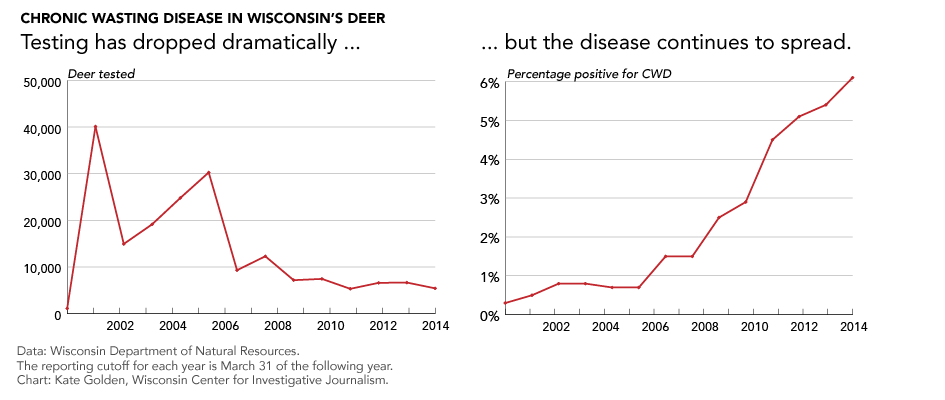Did Walker Cave In to Hunting Lobby?
Chronic Wasting Disease in deer is at all-time high because of changes in how DNR handles it.
Patrick Durkin, the Waupaca-based outdoor writer, had some fun with a recent state Department of Natural Resources press release regarding chronic wasting disease.
The release documenting the unmitigated spread of the always-fatal brain disease among deer, was titled: “Disease sampling results provide current snapshot of CWD in Wisconsin.” Durkin, in a column, jokingly suggested a comparable headline for a report on the sinking Titanic: “Damage-control party assesses condition of ship’s hull.”
Though fewer deer are being tested, the incidence of the disease is up. In the 2014 season, which ended March 31, more than 6 percent of the roughly 5,400 deer tested were positive, a DNR tally shows. That’s an all-time high disease rate; as recently as 2008, it was below 2 percent.
More alarming still, the disease rate among adult male deer has reached 40 percent in north-central Iowa County and around 25 percent in two other sectors. And CWD is no longer found only in southern Wisconsin.
Tami Ryan, the DNR’s wildlife health section chief, calls these numbers “not a good news scenario” but also not unexpected, given that the state is no longer attempting to manage the disease but is instead just monitoring its distribution and prevalence. Earlier attempts to employ more aggressive strategies were abandoned amid intense public opposition.
That’s not likely to happen. A far more plausible scenario is that the disease will continue to spread, infecting and killing deer, until the number of animals available for hunters is seriously depleted. And then, look out.
“The research we’ve done shows the disease is in an accelerating pace,” says Mike Samuel, a UW-Madison associate professor of wildlife ecology who studies CWD. “It’s going to continue to rise at a rapid pace and it’s going to continue to spread until the people decide we’ve had enough.”
And while Samuel sees no way to get rid of CWD, using currently available strategies, he thinks it can be controlled through management practices. He suggests killing more bucks, among whom the infection rate is highest, perhaps by opening the gun hunting season earlier, when deer rut (mate).
But this, Samuel notes, is when bow hunters do their thing, and they are a powerful lobby group. Past CWD-eradication strategies seen as detrimental to herd size drew opposition from hunters and were axed by lawmakers and Gov. Scott Walker. And Walker’s so-called “deer czar” recommended a more passive approach to CWD.
“We have a lot of ways to manage the disease that are politically unpopular,” Samuel says.
Michael Hansen, a senior staff scientist with the national Consumers Union who has long tracked the spread of CWD and related diseases, is appalled by what’s happening in Wisconsin.
“That’s horrendous news,” he says of the most recent numbers. “Do they not care about an epidemic that is sweeping the state? The science doesn’t matter to them?”
Hansen says the “proper response is to try and get rid of the epidemic, rather than just give up and let it sweep through.” Otherwise, it’s only a matter of time before “you’ve got such high rates that populations begin to crash.”
Dave Clausen, a veterinarian who formerly served on the state’s Natural Resources Board, shares this concern. “The current policy is inconsistent with a long-term healthy deer herd,” he says, diplomatically. What is happening now is exactly what he warned the DNR two years ago would happen, absent an aggressive response: “CWD will continue to spread across the state and will increase in prevalence where it is established.”
Now retired, Clausen calls the state’s willingness to essentially let this happen “a political decision, not a scientific one.” If the scientists are right, and Wisconsin’s deer hunt is devastated, will politicians get the blame?
Bill Lueders is the Money and Politics Project director at the Wisconsin Center for Investigative Journalism (www.WisconsinWatch.org). The Center produces the project in partnership with MapLight. The Center collaborates with Wisconsin Public Radio, Wisconsin Public Television, other news media and the UW-Madison School of Journalism and Mass Communication. All works created, published, posted or disseminated by the Center do not necessarily reflect the views or opinions of UW-Madison or any of its affiliates.
-
Wisconsin Lacks Clear System for Tracking Police Caught Lying
 May 9th, 2024 by Jacob Resneck
May 9th, 2024 by Jacob Resneck
-
Voters With Disabilities Demand Electronic Voting Option
 Apr 18th, 2024 by Alexander Shur
Apr 18th, 2024 by Alexander Shur
-
Few SNAP Recipients Reimbursed for Spoiled Food
 Apr 9th, 2024 by Addie Costello
Apr 9th, 2024 by Addie Costello






















Yes, but only after Scotty (thinks he’ll) have a new job, at which point it no longer matters to him.
It’s the same problem with just about every other shortsighted policy decision we’ve seen (from Madison) lately.
Regardless, it’ll be fun to watch an out-state-die-hard Republican hunter have to come to terms with it: Do I like my $100 tax cut or my hunting more?
> Did Walker Cave In to Hunting Lobby?
of course he did, in my opinion. it’s all about money and trade folks.
see;
‘’It is interesting to note that, in 2001, the State of Texas shifted its deer management strategies toward the same leanings that Kroll has suggested for Wisconsin. In Texas, the change was brought about via heavy lobbying from the high-fence deer ranching industry. This pressure helped convince the Texas Parks and Wildlife to change their regulations and allow private landowners to select the own deer biologists.’’
nothing like the wolf guarding the henhouse.
Texas just documented another case of CWD, I wonder what the Wisconsin’s Deer Czar (from TEXAS), seems Dr. Dough’s passive approach on CWD is not working out too well.
yep, while the Texas deer czar dr. dough was off to Wisconsin pushing the privately owned shooting pen industry (livestock cervid industry), Texas fell to CWD, and have now documented 7 cases of CWD to date.
IF Texas would test for CWD in the captive industry aggressively, I think we would all be shocked as to what they would find.
for your information…
According to Wisconsin’s White-Tailed Deer Trustee Dr. James Kroll, people who call for more public hunting opportunities are “pining for socialism.” He further states, “(Public) Game management is the last bastion of communism.”
“Game Management,” says James Kroll, driving to his high-fenced, two-hundred-acre spread near Nacogdoches, “is the last bastion of communism.” Kroll, also known as Dr. Deer, is the director of the Forestry Resources Institute of Texas at Stephen F. Austin State University, and the “management” he is referring to is the sort practiced by the State of Texas. The 55-year-old Kroll is the leading light in the field of private deer management as a means to add value to the land. His belief is so absolute that some detractors refer to him as Dr. Dough, implying that his eye is on the bottom line more than on the natural world.
Kroll, who has been the foremost proponent of deer ranching in Texas for more than thirty years, doesn’t mind the controversy and certainly doesn’t fade in the heat. People who call for more public lands are “cocktail conservationists,” he says, who are really pining for socialism. He calls national parks “wildlife ghettos” and flatly accuses the government of gross mismanagement. He argues that his relatively tiny acreage, marked by eight-foot fences and posted signs warning off would-be poachers, is a better model for keeping what’s natural natural while making money off the land.
Dr. Deer Wisconsin Report: Will High-Fence Bias Skew Final Plan?
Categories: Blogs, Daniel Schmidt’s Whitetail Wisdom, Deer News, Featured Tags: antler restricitons, dan schmidt, Dr. Deer, james kroll, James Kroll Wisconsin, qdm, quality deer management, texas hunting, wisconsin deer hunting March 29, 2012 According to Wisconsin’s White-Tailed Deer Trustee Dr. James Kroll, people who call for more public hunting opportunities are “pining for socialism.” He further states, “(Public) Game management is the last bastion of communism.”
OPINION BLOG
These are just two insights into the man who has been asked to provide analysis and recommended changes to Wisconsin’s deer management program. Kroll’s insights are from an article entitled “Which Side of the Fence Are You On?” by Joe Nick Patoski for a past edition of Texas Monthly. If nothing more, the article gives an unabashed look into the mind-set that will be providing the Wisconsin DNR with recommendations on how to change their deer management practices. James Kroll (also known as “Deer Dr.”) was appointed to the Wisconsin “deer czar” position last fall. He was hired by the Department of Administration and instructed to complete a review of the state’s deer management program.
Here’s a sample of the article:
“Game Management,” says James Kroll, driving to his high-fenced, two-hundred-acre spread near Nacogdoches, “is the last bastion of communism.” Kroll, also known as Dr. Deer, is the director of the Forestry Resources Institute of Texas at Stephen F. Austin State University, and the “management” he is referring to is the sort practiced by the State of Texas. The 55-year-old Kroll is the leading light in the field of private deer management as a means to add value to the land. His belief is so absolute that some detractors refer to him as Dr. Dough, implying that his eye is on the bottom line more than on the natural world.
Kroll, who has been the foremost proponent of deer ranching in Texas for more than thirty years, doesn’t mind the controversy and certainly doesn’t fade in the heat. People who call for more public lands are “cocktail conservationists,” he says, who are really pining for socialism. He calls national parks “wildlife ghettos” and flatly accuses the government of gross mismanagement. He argues that his relatively tiny acreage, marked by eight-foot fences and posted signs warning off would-be poachers, is a better model for keeping what’s natural natural while making money off the land.
A trip to South Africa six years ago convinced Kroll that he was on the right track. There he encountered areas of primitive, lush wildlife-rich habitats called game ranches. They were privately owned, privately managed, and enclosed by high fences. He noticed how most of the land outside those fences had been grazed to the nub, used up. “Game ranches there derive their income from these animals — viewing them, hunting them, selling their meat,” he says. “There are no losers.” At his own ranch Kroll has set up a smaller version of the same thing. His land is indeed lush, verdant, with pine groves, an abundance of undergrowth, wild orchids, New Jersey tea, jack-in-the-pulpits, and other native plants. He has also set up a full-scale breeding research center and is one of twenty Texas deer breeders using artificial insemination to improve his herd. “We balance sex and age ratio,” he says. “We manage habitat. We control the population and manage for hunting. I want to leave the deer herd better than it was before we came.”
It is interesting to note that, in 2001, the State of Texas shifted its deer management strategies toward the same leanings that Kroll has suggested for Wisconsin. In Texas, the change was brought about via heavy lobbying from the high-fence deer ranching industry. This pressure helped convince the Texas Parks and Wildlife to change their regulations and allow private landowners to select the own deer biologists.
“That has given landowners more freedom,” Kroll told Texas Monthly. “(However,) You still have to let the state on your land to get a wildlife-management permit.” The key difference here is that 98 percent of Texas is comprised of private land. Wisconsin, on the other hand, consists of approximately 34.8 million acres of land, and 25.5 percent of the state’s 638,000 gun-hunters reported hunting on public land at some point during the season (2010, Duey, Rees).
According to the Wisconsin Realtors Association, more than 5.7 million acres of this land, or 16.5 percent, is publicly owned and used for parks, forests, trails, and natural resource protection. [Note: these statistics do not include the public land used for roads, government buildings, military bases, and college/school campuses.] This 5.7 million acres of public land is owned as follows:
Federal government owns approximately 1.5 million acres (4.4 percent of the state’s land area). Almost all of the federal forestland in Wisconsin is located in Chequamegon-Nicolet National Forest.
State government owns approximately 1.6 million acres (4.6 percent of the state’s land area). The land is managed by two agencies, the Board of Commissioners of Public Land (who manages lands granted by federal government) and the DNR (managing land owned by the state).
County government owns approximately 2.6 million acres (7.5 percent of the state’s land area).
Public land is located in 71 of Wisconsin’s 72 counties, with the most public land located in Bayfield County (464,673 acres). [Note: Menominee County does not have any public land, but 98 percent of the land is held in trust by the Menominee Tribe.] Twenty counties have more than 100,000 acres of public land, while only 12 counties have fewer than 10,000 acres.
What does this all mean? My initial reaction, which is one that I predicted when Kroll was named to the state’s deer trustee position, is that his team’s final recommendations — if implemented — will be heavily skewed toward the state’s larger landowners (500+ acres) and folks who own small parcels in areas comprised mostly of private land.
It is also my prediction that the final recommendations (again, if implemented) will do little, if anything, to improve deer herds and deer hunting on Wisconsin’s 5.7 million acres of public land.
Where does this leave the public-land hunter? “It will suck to be you,” said one deer manager who asked to remain anonymous out of fear for his job. “The resources and efforts will go toward improving the private land sector. This is all about turning deer hunting away from the Public Land Doctrine and more toward a European-style of management — like they have in Texas.”
I do, of course, hope these assumptions are wrong. As with all things in life, we should maintain an open mind to change. Life is all about change. However, change for the sake of change is usually a recipe for disaster. Especially when that change is driven by something more than a sincere desire to manage public resources for the greater good.
As noted yesterday (Dr. James Kroll Report: Is That All You Get For Your Money), I will provide more of my opinions and interpretation on this important issue in forthcoming installments of this blog. Read his full preliminary report here.
http://www.texasmonthly.com/story/which-side-fence-are-you
http://www.texasmonthly.com/preview/2002-02-01/feature5
http://www.deeranddeerhunting.com/deer-news/dr-deer-wisconsin-report-will-high-fence-hunting-bias-skew-final-plan
snip…see full text ;
Thursday, March 29, 2012
TEXAS DEER CZAR SAYS WISCONSIN DNR NOT DOING ENOUGH ABOUT CWD LIKE POT CALLING KETTLE BLACK
http://chronic-wasting-disease.blogspot.com/2012/03/texas-deer-czar-says-wisconsin-dnr-not.html
Friday, June 01, 2012
*** TEXAS DEER CZAR TO WISCONSIN ASK TO EXPLAIN COMMENTS
http://chronic-wasting-disease.blogspot.com/2012/06/texas-deer-czar-to-wisconsin-ask-to.html
Tuesday, July 10, 2012
Dr. James C. Kroll Texas deer czar final report on Wisconsin
http://chronic-wasting-disease.blogspot.com/2012/07/dr-james-c-kroll-texas-deer-czar-final.html
Wednesday, March 18, 2015
Chronic Wasting Disease CWD Confirmed Texas Trans Pecos March 18, 2015
http://chronic-wasting-disease.blogspot.com/2015/03/chronic-wasting-disease-cwd-confirmed.html
Wednesday, March 25, 2015
Chronic Wasting Disease CWD Cases Confirmed In New Mexico 2013 and 2014 UPDATE 2015
http://chronic-wasting-disease.blogspot.com/2015/03/chronic-wasting-disease-cwd-cases.html
Tuesday, October 07, 2014
*** Wisconsin white-tailed deer tested positive for CWD on a Richland County breeding farm, and a case of CWD has been discovered on a Marathon County hunting preserve
http://chronic-wasting-disease.blogspot.com/2014/10/wisconsin-white-tailed-deer-tested.html
Wednesday, March 04, 2015
Disease sampling results provide current snapshot of CWD in Wisconsin finding 324 positive detections statewide in 2014
http://chronic-wasting-disease.blogspot.com/2015/03/disease-sampling-results-provide.html
Terry S. Singeltary Sr.
Tuesday, August 11, 2015
Why Has the Federal Government Cut Funding for Chronic Wasting Disease Research?
http://chronic-wasting-disease.blogspot.com/2015/08/why-has-federal-government-cut-funding.html
Tuesday, August 11, 2015
Wisconsin doing what it does best, procrastinating about CWD yet again thanks to Governor Walker
http://chronic-wasting-disease.blogspot.com/2015/08/wisconsin-doing-what-it-does-best.html
Thursday, August 06, 2015
WE HAVE LOST TEXAS TO CWD TASK FORCE CATERING TO INDUSTRY
http://chronic-wasting-disease.blogspot.com/2015/08/we-have-lost-texas-to-cwd-task-force.html
HAVE YOU BEEN THUNDERSTRUCK ?
http://chronic-wasting-disease.blogspot.com/2015/08/texas-cwd-have-you-been-thunderstruck.html
Thursday, August 13, 2015
Iatrogenic CJD due to pituitary-derived growth hormone with genetically determined incubation times of up to 40 years
http://creutzfeldt-jakob-disease.blogspot.com/2015/08/iatrogenic-cjd-due-to-pituitary-derived.html